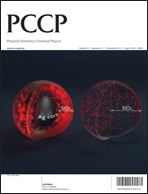Orientational order-dependent thermal expansion and compressibility of ZrW2O8 and ZrMo2O8†
Abstract
The role of MO4 (M = W, Mo) orientational disorder in the thermal expansion and compressibility of ZrW2O8 and ZrMo2O8 was investigated via in situ powder X-ray diffraction at elevated temperature and pressure. A dramatic reduction in the bulk modulus of α-ZrW2O8, which has ordered WO4 tetrahedra at room temperature, from 65 GPa at room temperature to 47 GPa at 386 K was observed to be concomitant with the onset of a reversible WO4 orientational disordering upon compression. Additionally, the coefficient of thermal expansion (CTE) of the α phase became more negative upon compression within the temperature range in which pressure-dependent disorder was observed; αl, over the range 298 to 386 K, was ∼−11 ppm K−1 at 35 MPa but ∼−16 ppm K−1 at 276 MPa. No softening upon heating or change in CTE upon compression was observed for ZrW2O8 above the order → disorder phase transition temperature. Cubic ZrMo2O8 has a disordered arrangement of MoO4 tetrahedra at all temperatures and pressures accessed in this study. Its bulk modulus was independent of temperature, and its CTE was insensitive to pressure, much like β-ZrW2O8. The stability/metastability of the cubic and orthorhombic phases upon heating above room temperature and compression is discussed, with a focus on changes in the thermodynamics and kinetics of the cubic ↔ orthorhombic transition.


 Please wait while we load your content...
Please wait while we load your content...